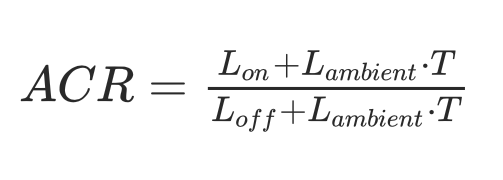Difference between revisions of "Augmented Reality Wearables 3ARW"
Jump to navigation
Jump to search
(Added some FOMs) |
(Added more FOMs) |
||
| Line 13: | Line 13: | ||
== Figures of Merit (FOMs) == | == Figures of Merit (FOMs) == | ||
* '''Unit Cost [$] | * '''Unit Cost''' [$]: Unit cost to manufacture the device. | ||
* '''Clock Speed [GHz] | * '''Clock Speed''' [GHz]: Speed of the processor (i.e., the number of processor cycles executed per second) | ||
* '''Ambient Contrast Ratio (ACR) [%] | * '''Ambient Contrast Ratio (ACR)''' [%]: Ratio of display luminance for on and off state [1]. | ||
[[File:Ambient-contrast-ratio-def.png]] | |||
* '''Resolution Density''' [ppd, pixels-per-degree]: Total number of pixels in a display, which is directly related to the quality of the image (i.e., sharpness) | |||
*'''Field of View''' [degrees]: Total angular range of the display or image visible to both eyes | |||
*'''Display Luminance''' [nits]: Brightness of the display | |||
*'''Weight''' [lbs]: Heaviness of the wearable device and its required parts | |||
*'''Pixel Response Time''' [ms]: Time required for a pixel to change. Longer times signify slower transitions resulting in visual artifacts when displaying rapidly changing images. | |||
*'''Refresh Rate''' [Hz]: Frequency of display updates per second. | |||
* Memory [GB]: Total storage capacity of device | |||
* Training Time [hrs]: Average number of hours needed to set up and learn to use device | |||
* Longevity: | |||
** Single-use Lifespan [hrs]: Time of use afforded by a single charge of the device | |||
** Total Lifespan [#]: Total number of charges afforded by device | |||
== References == | == References == | ||
1. Yun-Han LEE, Tao ZHAN, Shin-Tson WU, Prospects and challenges in augmented reality displays, Virtual Reality & Intelligent Hardware, Volume 1, Issue 1, 2019, Pages 10-20, ISSN 2096-5796, https://doi.org/10.3724/SP.J.2096-5796.2018.0009. | 1. Yun-Han LEE, Tao ZHAN, Shin-Tson WU, Prospects and challenges in augmented reality displays, Virtual Reality & Intelligent Hardware, Volume 1, Issue 1, 2019, Pages 10-20, ISSN 2096-5796, https://doi.org/10.3724/SP.J.2096-5796.2018.0009. | ||
Revision as of 21:44, 10 October 2021
By: Hannah Munguia-Flores, Joonhee Kim, Jacqueline Lee
Roadmap Overview
Design Structure Matrix (DSM) Allocation
Roadmap Model
We provide an Object-Process-Diagram (OPD) of the 3ARW roadmap below.
Figures of Merit (FOMs)
- Unit Cost [$]: Unit cost to manufacture the device.
- Clock Speed [GHz]: Speed of the processor (i.e., the number of processor cycles executed per second)
- Ambient Contrast Ratio (ACR) [%]: Ratio of display luminance for on and off state [1].
- Resolution Density [ppd, pixels-per-degree]: Total number of pixels in a display, which is directly related to the quality of the image (i.e., sharpness)
- Field of View [degrees]: Total angular range of the display or image visible to both eyes
- Display Luminance [nits]: Brightness of the display
- Weight [lbs]: Heaviness of the wearable device and its required parts
- Pixel Response Time [ms]: Time required for a pixel to change. Longer times signify slower transitions resulting in visual artifacts when displaying rapidly changing images.
- Refresh Rate [Hz]: Frequency of display updates per second.
- Memory [GB]: Total storage capacity of device
- Training Time [hrs]: Average number of hours needed to set up and learn to use device
- Longevity:
- Single-use Lifespan [hrs]: Time of use afforded by a single charge of the device
- Total Lifespan [#]: Total number of charges afforded by device
References
1. Yun-Han LEE, Tao ZHAN, Shin-Tson WU, Prospects and challenges in augmented reality displays, Virtual Reality & Intelligent Hardware, Volume 1, Issue 1, 2019, Pages 10-20, ISSN 2096-5796, https://doi.org/10.3724/SP.J.2096-5796.2018.0009.
